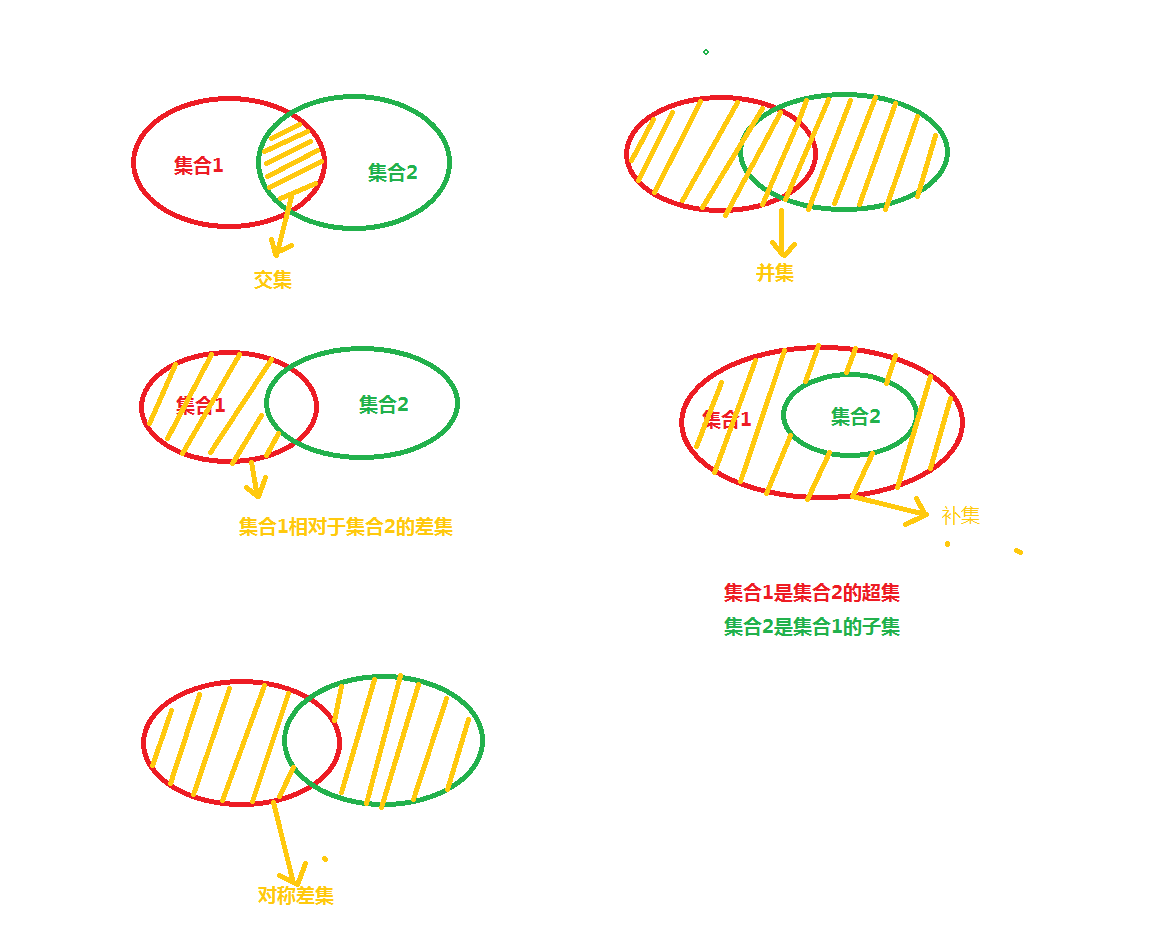关键词:C# List 集合 交集、并集、差集、去重, 对象集合、 对象、引用类型、交并差、List<T>
有时候看官网文档是最高效的学习方式!
一、简单集合
Intersect 交集,Except 差集,Union 并集
int[] oldArray = { 1, 2, 3, 4, 5 };
int[] newArray = { 2, 4, 5, 7, 8, 9 };
var jiaoJi = oldArray.Intersect(newArray).ToList();//2,4,5
var oldChaJi = oldArray.Except(newArray).ToList();//1,3
var newChaJi = newArray.Except(oldArray).ToList();//7,8,9
var bingJi = oldArray.Union(newArray).ToList();//1,2,3,4,5,7,8,9
二、对象集合
Product[] store1 = { new Product { Name = "apple", Code = 9 }, new Product { Name = "orange", Code = 4 } }; Product[] store2 = { new Product { Name = "apple", Code = 9 }, new Product { Name = "lemon", Code = 12 } }; IEnumerable<Product> union =store1.Union(store2,new ProductComparer()); IEnumerable<Product> except=store1.Except(store2,new ProductComparer()); IEnumerable<Product> intersect=store1.Intersect(store2,new ProductComparer()); IEnumerable<Product> distinct=store1.Distinct(store2,new ProductComparer());
小提示:
1:IEnumerable<Product> 可以简化为 匿名类型 var
var distinct=store1.Distinct(store2,new ProductComparer());
2: 可以继续进行一些linq或拉姆达操作
var distinct=store1.Distinct(store2,new ProductComparer()).OrderBy(c=>c.Code);
原因是引用了linq组件:using System.Linq;
public class Product
{
public string Name { get; set; }
public int Code { get; set; }
}
核心代码:简单情况
//如果对象存在唯一主键,例如:从数据库里查询出来的数据存在 ID class ProductComparer : IEqualityComparer<Product> { // Products are equal if their names and product numbers are equal. public bool Equals(Product x, Product y) { //Check whether the compared objects reference the same data. if (Object.ReferenceEquals(x, y)) return true; //Check whether any of the compared objects is null. if (Object.ReferenceEquals(x, null) || Object.ReferenceEquals(y, null)) return false; //Check whether the products' properties are equal. return x.ID == y.ID; } // If Equals() returns true for a pair of objects // then GetHashCode() must return the same value for these objects. public int GetHashCode(Product product) { //Check whether the object is null if (Object.ReferenceEquals(product, null)) return 0; //Get hash code for the Code field. int hashID = product.ID.GetHashCode(); //Calculate the hash code for the product. return hashID; } }
核心代码:复杂情况
// 如果存在组合主键或组合唯一索引,即多个字段组合才能确定唯一性。 // Custom comparer for the Product class class ProductComparer : IEqualityComparer<Product> { // Products are equal if their names and product numbers are equal. public bool Equals(Product x, Product y) { //Check whether the compared objects reference the same data. if (Object.ReferenceEquals(x, y)) return true; //Check whether any of the compared objects is null. if (Object.ReferenceEquals(x, null) || Object.ReferenceEquals(y, null)) return false; //Check whether the products' properties are equal. return x.Code == y.Code && x.Name == y.Name; } // If Equals() returns true for a pair of objects // then GetHashCode() must return the same value for these objects. public int GetHashCode(Product product) { //Check whether the object is null if (Object.ReferenceEquals(product, null)) return 0; //Get hash code for the Name field if it is not null. int hashProductName = product.Name == null ? 0 : product.Name.GetHashCode(); //Get hash code for the Code field. int hashProductCode = product.Code.GetHashCode(); //Calculate the hash code for the product. return hashProductName ^ hashProductCode; } }
合交并差 核心代码是相同的: IEqualityComparer 。
三、微软官方文档
union :https://docs.microsoft.com/zh-cn/dotnet/api/system.linq.enumerable.union?view=netframework-4.8
intersect:https://docs.microsoft.com/zh-cn/dotnet/api/system.linq.enumerable.intersect?view=netframework-4.8
except:https://docs.microsoft.com/zh-cn/dotnet/api/system.linq.enumerable.except?view=netframework-4.8
distinct:https://docs.microsoft.com/zh-cn/dotnet/api/system.linq.enumerable.distinct?view=netframework-4.8
合交并差 核心代码是相同的: IEqualityComparer 。
建议在看看文档其它部分,以备后用,文档写的很棒!
例如:join 某些情况与union等效。
四、交集、并集、差集、补集、对称差集 示意图,

后两者后可以有前三者演变而来。补集可以求差或去重、对称差集可以先求差、在求并;
参考过的文章
https://www.oschina.net/code/snippet_222150_16997
http://www.cnblogs.com/flywing/p/5912242.html
https://blog.csdn.net/wizblack/article/details/78796557





















 2065
2065











 被折叠的 条评论
为什么被折叠?
被折叠的 条评论
为什么被折叠?








